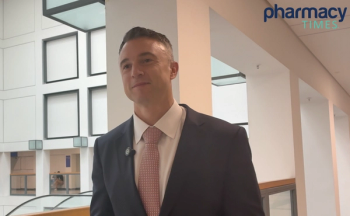
Consider Real-World Barriers When Deciding on Treatment for Diabetic Macular Edema
Pharmacists will play a growing role in the use of biosimilars and guiding patients through the switching process.
With a range of anti-VEGF treatments, corticosteroids, and biosimilars for the treatment of diabetic macular edema (DME), pharmacists and other clinicians should carefully consider real-world barriers and challenges for patients, according to a presentation at the
More than 28 million people worldwide are living with DME and it is a leading cause of vision loss in patients with diabetes, according to presenter Joseph Nezgoda, MD, MBA. Common symptoms include blurred center vision, dull or washed-out colors, and straight lines that appear wavy. Risk factors for DME include diabetes, hyperglycemia, Black or Hispanic race, diabetic retinopathy, high blood pressure, and smoking.
“Duration of diabetes is very important, and those who have it over 10 years are much more likely to lose vision,” Nezgoda explained.
DME significantly affects quality of life for patients and their caretakers. Additionally, the time taken for frequent injections and physicians’ office visits takes time away from family, friends, leisure, and activities of daily living.
Similar to other disease states, DME care is affected by disparities, including social, behavioral, biological, and environmental determinants. Nezgoda particularly emphasized that racial disparities in clinical research have a significant impact.
“Representation in clinical trials is not equal, it’s not representative of the US population,” Nezgoda said. “There’s certainly an increased need for racial and ethnic minority representation in clinical trials to improve external validity.”
Treatment for DME includes blood pressure and glucose management, as well as anti-VEGF treatments, corticosteroids, and surgical options. Nezgoda noted that surgery is typically reserved for patients with severe DME who are at risk of complete vision loss, but improved treatments and early diagnosis are making this less necessary.
Nezgoda said anti-VEGF treatments are really the cornerstone of DME management. Available anti-VEGF products include bevacizumab; ranibizumab and its biosimilar; aflibercept; brolucizumab; and faricimab. With the exception of bevacizumab, all of these products are FDA-approved for DME.
Bevacizumab has off-label use for retinal diseases, with standard DME dosing at 1.25 mg intravitreal injection once monthly.
“Bevacizumab is the one that started it all,” Nezgoda said. “It was the first approved VEGF on the market and used in several cancer diagnoses. It has a mechanism of action against VEGF…which will increase permeability, inflammation, and neovascularization, and this is why it was targeted.”
All anti-VEGF treatments have similar safety concerns, including blurred vision, conjunctival hemorrhage, eye pain, vitreous detachment, and vitreous floaters. The administration via intravitreal injection can also lead to some challenges and risks.
Corticosteroids are another potential treatment approach, including triamcinolone acetonide, fluocinolone acetonide implant, or dexamethasone implant. Safety concerns with these options include elevated intraocular pressure and cataract development, and these are typically second-line options due to the strong supporting data with anti-VEGF treatments.
“Corticosteroids have been used in DME for a long, long time,” Nezgoda said. “The anti-VEGF era really kicked off in the 2000s, but prior to that we had corticosteroids and all the different mechanisms of administration.”
Biosimilars are also expected to play a growing role as more become available.
Turning to a discussion of more logistics and challenges in DME treatment, presenter Yuqian Liu, PharmD, RPh, said it is important to consider real-world challenges rather than solely clinical trial data. In the real-world setting, patients often have poor adherence resulting in a low frequency of treatment and low monitoring for disease progression.
To manage these obstacles, it is important to consider drug costs as well as direct and indirect costs to patients. Potential solutions to these obstacles include extended-interval treatment methods, longer-lasting therapies with lower injection frequency, patient-specific treatment plans, and improved counseling on the disease state and why these treatments are necessary.
“One of the potential solutions for adherence is what’s known as the treat-and-extend approach,” Liu explained. “If the patient is unable to stick to a high treatment frequency regimen or is unable to stay adherent to their therapy, a lot of providers will attempt this method.”
The treat-and-extend approach allows patients to go longer between injections as long as they remain stable, potentially alleviating challenges with cost, time spent at physicians’ offices, and transportation obstacles.
All DME treatments currently fall under the specialty category, giving specialty pharmacists a key role to play. Bevacizumab, in particular, is dispensed by specialty compounding pharmacies that must be regulation-compliant and FDA-authorized.
In addition to compounding and providing the medications, pharmacists will also play an important role in the growing use of biosimilars.
“Now it’s a chance for the specialty pharmacy and the pharmacist to start thinking about how do you increase patient awareness of biosimilars? How do you provide the education to the patient so they understand what the biosimilar is, why they are getting switched to the biosimilar, and help facilitate that process and make it as smooth as possible,” Liu said.
Facilitating a patient-centered approach is crucial throughout all of these treatment decisions, Liu said. The 4 pillars of a patient-centered approach include exploring health, disease, and the illness experience with the patient; enhancing the patient-centered relationship; understanding the entire person and their unique needs; and finding common ground between the patient and providers.
“As pharmacists, we really need to start thinking about how we support the overall patient as a whole and understanding the patient’s clinical profile to best guide our therapy and clinical decisions,” Liu concluded.
REFERENCE
Nezgoda J, Liu Y. The Promising Role of Novel Targeted Therapies in Addressing Clinical and Economic Burdens in Diabetic Macular Edema. Presented at: 2023 Asembia Specialty Pharmacy Summit. May 2, 2023. Accessed May 2, 2023.
Newsletter
Stay informed on drug updates, treatment guidelines, and pharmacy practice trends—subscribe to Pharmacy Times for weekly clinical insights.




















































































































































































































